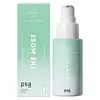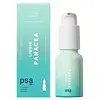What's inside
What's inside
 Key Ingredients
Key Ingredients

 Benefits
Benefits

 Concerns
Concerns

No concerns
 Ingredients Side-by-side
Ingredients Side-by-side

Water
Skin ConditioningGlycerin
HumectantCarthamus Tinctorius Seed Oil
MaskingPropanediol
SolventDimethyl Isosorbide
SolventGlucuronolactone
Skin ConditioningLeuconostoc/Radish Root Ferment Filtrate
AntimicrobialBisabolol
MaskingPolysorbate 20
EmulsifyingHyaluronic Acid
HumectantSodium Hyaluronate
HumectantSodium Hyaluronate Crosspolymer-3
HumectantSodium PCA
HumectantPanthenol
Skin ConditioningSaccharomyces/Xylinum/Black Tea Ferment
Skin ConditioningEuterpe Oleracea Fruit Extract
Madecassoside
AntioxidantGlycyrrhiza Glabra Root Extract
BleachingChondrus Crispus Extract
Skin ConditioningAllantoin
Skin ConditioningHydrolyzed Jojoba Esters
Skin ConditioningGluconolactone
Skin ConditioningSodium Lactate
BufferingSodium Gluconate
Skin ConditioningHydroxyethylcellulose
Emulsion StabilisingSodium Benzoate
MaskingSclerotium Gum
Emulsion StabilisingHydroxyethyl Acrylate/Sodium Acryloyldimethyl Taurate Copolymer
Emulsion StabilisingPotassium Sorbate
PreservativePhenoxyethanol
PreservativeWater, Glycerin, Carthamus Tinctorius Seed Oil, Propanediol, Dimethyl Isosorbide, Glucuronolactone, Leuconostoc/Radish Root Ferment Filtrate, Bisabolol, Polysorbate 20, Hyaluronic Acid, Sodium Hyaluronate, Sodium Hyaluronate Crosspolymer-3, Sodium PCA, Panthenol, Saccharomyces/Xylinum/Black Tea Ferment, Euterpe Oleracea Fruit Extract, Madecassoside, Glycyrrhiza Glabra Root Extract, Chondrus Crispus Extract, Allantoin, Hydrolyzed Jojoba Esters, Gluconolactone, Sodium Lactate, Sodium Gluconate, Hydroxyethylcellulose, Sodium Benzoate, Sclerotium Gum, Hydroxyethyl Acrylate/Sodium Acryloyldimethyl Taurate Copolymer, Potassium Sorbate, Phenoxyethanol
Water
Skin ConditioningGlycerin
HumectantPolyglyceryl-4 Laurate
EmulsifyingTocopheryl Acetate
AntioxidantSaccharomyces/Xylinum/Black Tea Ferment
Skin ConditioningCarthamus Tinctorius Seed Oil
MaskingLeuconostoc/Radish Root Ferment Filtrate
AntimicrobialCaprylyl Glycol
EmollientLauryl Laurate
Skin ConditioningCentella Asiatica Leaf Extract
Skin ConditioningCamellia Sinensis Leaf Extract
AntimicrobialCentella Asiatica Meristem Cell Culture
AntioxidantMadecassoside
AntioxidantBisabolol
MaskingSodium Hyaluronate
HumectantHyaluronic Acid
HumectantCandelilla/Jojoba/Rice Bran Polyglyceryl-3 Esters
EmulsifyingHydroxyethylcellulose
Emulsion StabilisingXanthan Gum
EmulsifyingGlyceryl Stearate
EmollientC12-15 Alkyl Benzoate
AntimicrobialSodium Gluconate
Skin ConditioningSodium Stearoyl Glutamate
CleansingPotassium Sorbate
PreservativeHydroxyethyl Acrylate/Sodium Acryloyldimethyl Taurate Copolymer
Emulsion StabilisingCetearyl Alcohol
EmollientCitric Acid
BufferingSodium Stearoyl Lactylate
EmulsifyingPhenoxyethanol
PreservativeWater, Glycerin, Polyglyceryl-4 Laurate, Tocopheryl Acetate, Saccharomyces/Xylinum/Black Tea Ferment, Carthamus Tinctorius Seed Oil, Leuconostoc/Radish Root Ferment Filtrate, Caprylyl Glycol, Lauryl Laurate, Centella Asiatica Leaf Extract, Camellia Sinensis Leaf Extract, Centella Asiatica Meristem Cell Culture, Madecassoside, Bisabolol, Sodium Hyaluronate, Hyaluronic Acid, Candelilla/Jojoba/Rice Bran Polyglyceryl-3 Esters, Hydroxyethylcellulose, Xanthan Gum, Glyceryl Stearate, C12-15 Alkyl Benzoate, Sodium Gluconate, Sodium Stearoyl Glutamate, Potassium Sorbate, Hydroxyethyl Acrylate/Sodium Acryloyldimethyl Taurate Copolymer, Cetearyl Alcohol, Citric Acid, Sodium Stearoyl Lactylate, Phenoxyethanol
 Reviews
Reviews

Ingredients Explained
These ingredients are found in both products.
Ingredients higher up in an ingredient list are typically present in a larger amount.
Bisabolol is famous for its skin soothing properties. It does this by blocking inflammatory signals, helping to reduce your body's reaction to irritation.
This ingredient also interferes with the process of hyperpigmentation. This can help with reducing dark spots and uneven tone.
Bisabolol is an antioxidant. Antioxidants help fight free-radicals. Free-radicals are molecules that may damage your skin cells. By fighting these free-radicals, Bisabolol may slow down signs of aging.
Studies have shown Bisabolol to have antimicrobial properties and may be a fungicide. These properties help preserve a product's shelf life.
All these properties makes bisabolol a great skin barrier helper ingredient.
Bisabolol also helps the absorption of other ingredients.
Note: Synthetic Bisabolol has been shown to be less effective.
Learn more about BisabololCarthamus tinctorius seed oil comes from safflower, one of humanity's oldest crops.
Safflower seed oil contains a high percentage of linoleic acid and oleic acid. It also contains Vitamin E. These three components are effective moisturizers.
Vitamin E helps nourish your skin's lipid barrier. It is also a potent antioxidant. Antioxidants help fight free-radical molecules, or unstable molecules that may damage your skin cells.
Due to its high fatty acid content, this ingredient may not be malassezia folliculitis safe.
Thoughout history, safflower has been used for dying fabrics and in food as a saffron substitute.
Learn more about Carthamus Tinctorius Seed OilGlycerin is already naturally found in your skin. It helps moisturize and protect your skin.
A study from 2016 found glycerin to be more effective as a humectant than AHAs and hyaluronic acid.
As a humectant, it helps the skin stay hydrated by pulling moisture to your skin. The low molecular weight of glycerin allows it to pull moisture into the deeper layers of your skin.
Hydrated skin improves your skin barrier; Your skin barrier helps protect against irritants and bacteria.
Glycerin has also been found to have antimicrobial and antiviral properties. Due to these properties, glycerin is often used in wound and burn treatments.
In cosmetics, glycerin is usually derived from plants such as soybean or palm. However, it can also be sourced from animals, such as tallow or animal fat.
This ingredient is organic, colorless, odorless, and non-toxic.
Glycerin is the name for this ingredient in American English. British English uses Glycerol/Glycerine.
Learn more about GlycerinHyaluronic acid is naturally found in healthy skin. It is a humectant, meaning it draws moisture to your skin.
This ingredient helps hydrate, soothe, and protect the skin.
What makes hyaluronic acid so hydrating? It has the capacity to bind or hold large amounts of water.
Fun fact: It is already naturally found in our bodies, such as the fluids of our eyes and our joints.
Studies find this ingredient to have anti-inflammatory and anti-microbial properties. This can help speed up wound-healing.
Hyaluronic acid can be irritating if the molecule has a low-molecular weight, or if the molecules are small.
One study found low-molecular weight hyaluronic acid to be pro-inflammatory, meaning some people may experience irritation. This is because our bodies use hyaluronic acid in the wound-healing process to signal to our bodies, via irritation, that something needs healing.
The same study found high-molecular weight hyaluronic acid to be anti-inflammatory.
These are some other common types of Hyaluronic Acid:
Learn more about Hyaluronic AcidThis is a synthetic polymer. It helps improve the texture of products by adding thickness and gel-like feel.
It is also an emulsifer, meaning it prevents ingredients such as oil and water from separating. It also helps evenly disperse other ingredients.
Hydroxyethylcellulose is used to improve the texture of products. It is created from a chemical reaction involving ethylene oxide and alkali-cellulose. Cellulose is a sugar found in plant cell walls and help give plants structure.
This ingredient helps stabilize products by preventing ingredients from separating. It can also help thicken the texture of a product.
This ingredient can also be found in pill medicines to help our bodies digest other ingredients.
Learn more about HydroxyethylcelluloseLeuconostoc/Radish Root Ferment Filtrate is a natural preservative. It comes from fermenting radish roots with a bacteria called leuconostoc.
Leuconostoc comes from lactic acid.
This ingredient has antimicrobial properties and helps prevent the growth of bacteria in a product.
Leuconostoc is used to make the traditional Korean side-dish, kimchi. It is also used to make sourdough bread (both incredibly yummy foods).
Learn more about Leuconostoc/Radish Root Ferment FiltrateMadecassoside comes from the super popular skin-soothing ingredient, Centella asiatica. It is one of four active compounds found in the extract of Centella Asiatica.
Madecassoside has antioxidant, anti-inflammatory, and hydrating properties. It contains fatty acids, amino acids, beta-carotene, and phytochemicals.
One study found using Madecassoside with ascorbic acid helped reduce the signs of aging and improved skin hydration.
Learn more about MadecassosidePhenoxyethanol is a preservative that has germicide, antimicrobial, and aromatic properties. Studies show that phenoxyethanol can prevent microbial growth. By itself, it has a scent that is similar to that of a rose.
It's often used in formulations along with Caprylyl Glycol to preserve the shelf life of products.
Potassium Sorbate is a preservative used to prevent yeast and mold in products. It is commonly found in both cosmetic and food products.
This ingredient comes from potassium salt derived from sorbic acid. Sorbic acid is a natural antibiotic and effective against fungus.
Both potassium sorbate and sorbic acid can be found in baked goods, cheeses, dried meats, dried fruit, ice cream, pickles, wine, yogurt, and more.
You'll often find this ingredient used with other preservatives.
Learn more about Potassium SorbateThis combination of bacteria + black tea + fermentation = kombucha.
According to a manufacturer, this ingredient helps boost radiance, smoothness, and thickens skin.
You can read about the skin benefits of the individual parts here:
Saccharomyces
Black tea
This is the synthetic salt of gluconic acid, a form of PHA and mild exfoliant.
It is mainly used to stabilize oil and butter formulations from going bad. Sodium gluconate is a humectant, pH regulator, and chelating agent.
Chelating agents help neutralize unwanted metals from affecting the formulation.
Sodium gluconate is water-soluble.
Learn more about Sodium GluconateSodium Hyaluronate is hyaluronic acid's salt form. It is commonly derived from the sodium salt of hyaluronic acid.
Like hyaluronic acid, it is great at holding water and acts as a humectant. This makes it a great skin hydrating ingredient.
Sodium Hyaluronate is naturally occurring in our bodies and is mostly found in eye fluid and joints.
These are some other common types of Hyaluronic Acid:
Learn more about Sodium HyaluronateWater. It's the most common cosmetic ingredient of all. You'll usually see it at the top of ingredient lists, meaning that it makes up the largest part of the product.
So why is it so popular? Water most often acts as a solvent - this means that it helps dissolve other ingredients into the formulation.
You'll also recognize water as that liquid we all need to stay alive. If you see this, drink a glass of water. Stay hydrated!
Learn more about Water